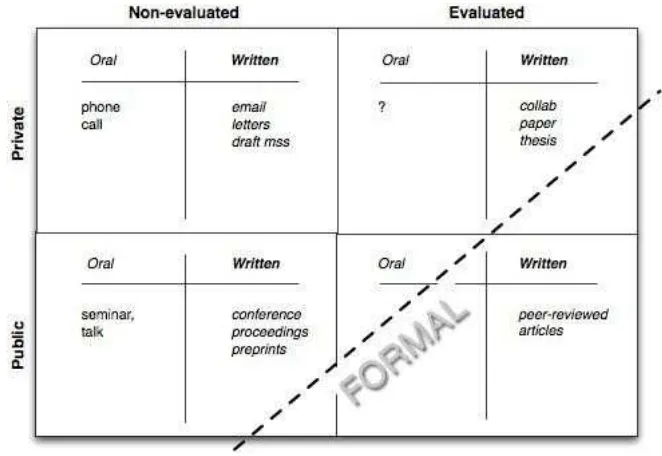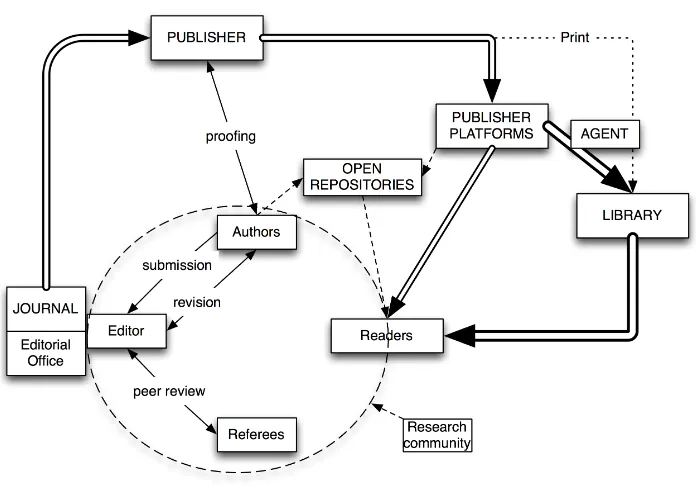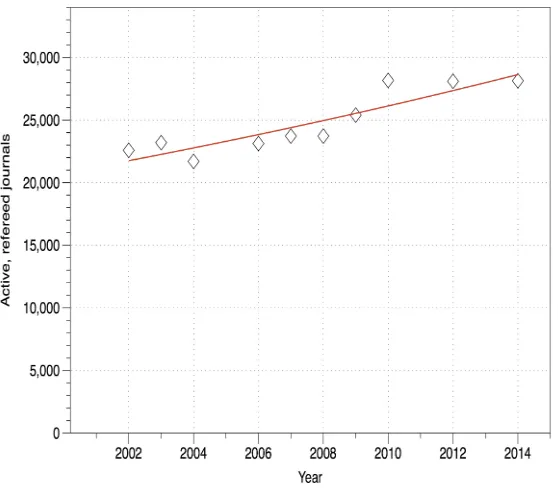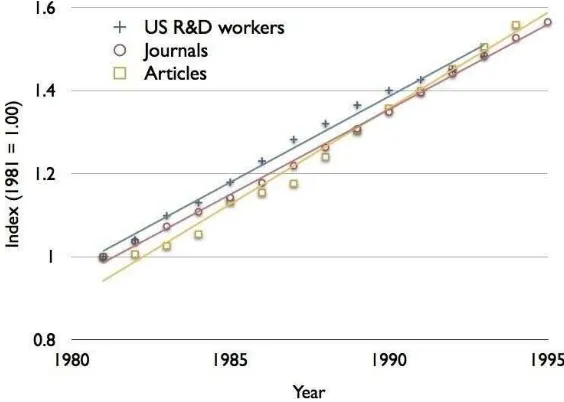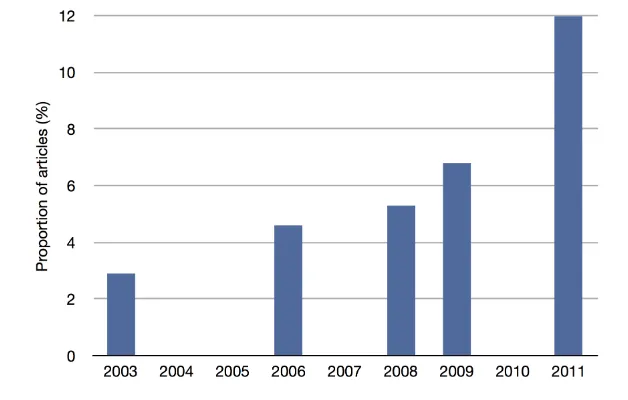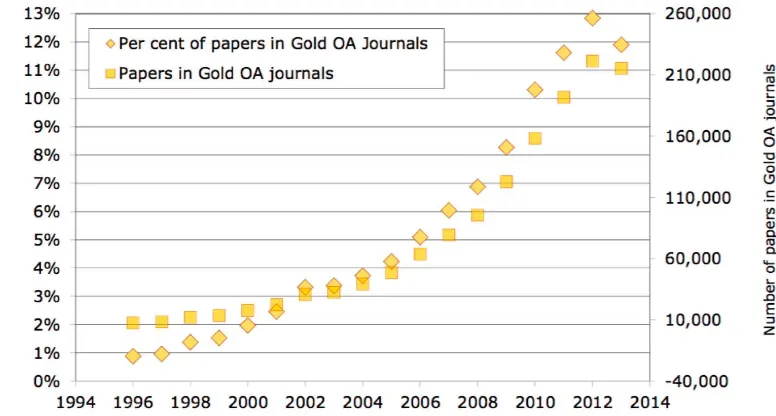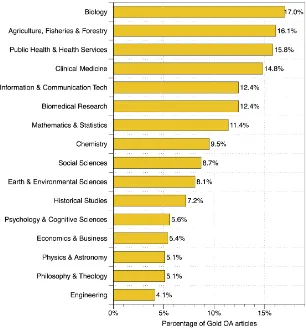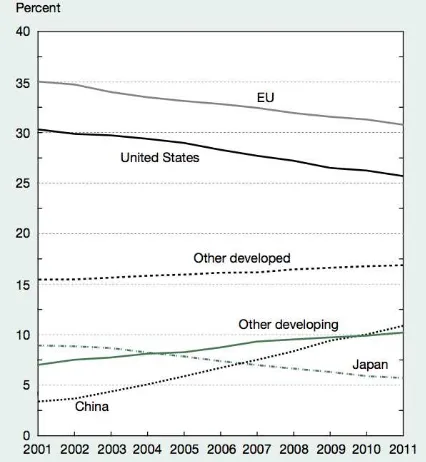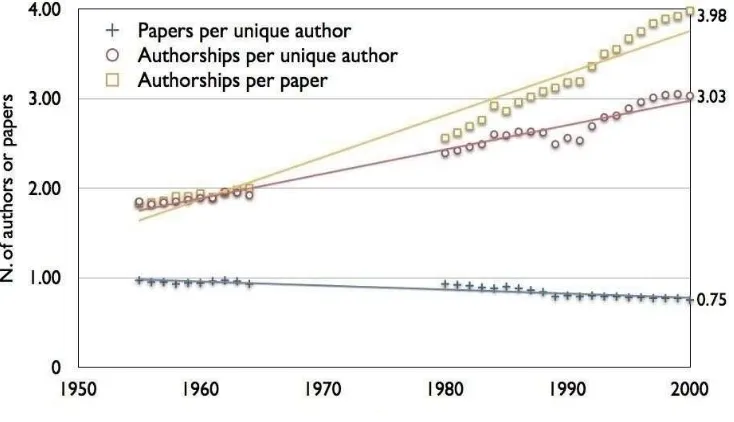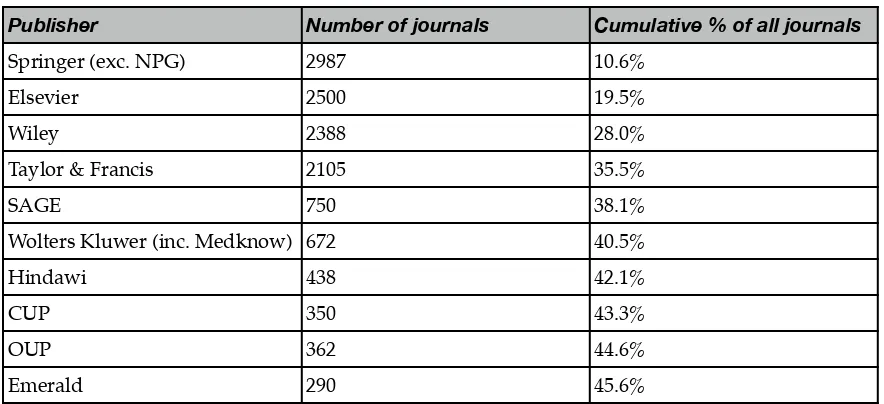Celebrating the 350
thanniversary of journal publishing
The STM Report
An overview of scientific and scholarly journal publishing
Mark Ware
Michael Mabe
Fourth Edition
March 2015
Mark Ware Consulting
The STM Report, Fourth Edition March 2015
© 2015 STM: International Association of Scientific, Technical and Medical Publishers Fourth Edition published March 2015; updated with minor revisions November 2015
Published by
International Association of Scientific, Technical and Medical Publishers Prins Willem Alexanderhof 5, The Hague, 2595BE, The Netherlands
About STM
STM is the leading global trade association for academic and professional publishers. It has over 120 members in 21 countries who each year collectively publish nearly 66% of all journal articles and tens of thousands of monographs and reference works. STM members include learned societies, university presses, private companies, new starts and established players.
STM Aims and Objectives
• to assist publishers and their authors in their activities in disseminating the results of research in the fields of science, technology and medicine;
• to assist national and international organisations and communications industries in the electronic environment, who are concerned with improving the dissemination, storage and retrieval of scientific, technical and medical information;
• to carry out the foregoing work of the Association in conjunction with the International Publishers Association (IPA) and with the national publishers associations and such other governmental and professional bodies, international and national, who may be concerned with these tasks.
STM participates in the development of information identification protocols and electronic copyright management systems. STM members are kept fully up to date (via newsletters, the STM website, and e-mail) about the issues which will ultimately affect their business. STM organises seminars,training courses, and conferences.
Mark Ware Consulting provides publishing consultancy services to the STM and B2B sectors. For more information see www.markwareconsulting.com.
!
Contents
Types of scholarly communication
!
13
...
Changes in scholarly communication system
!
14
...
The journal
!
16
...
What is a journal?
!
16
...
The journals publishing cycle
!
16
...
Sales channels and models
!
19
...
Journal economics and market size
!
23
...
Journal and articles numbers and trends
!
27
...
Global trends in scientific output
!
36
...
Citations and the Impact Factor
!
58
...
Costs of journal publishing
!
66
...
Authors’ behaviour, perceptions and attitudes
!
69
...
Researchers’ access to journals
!
83
...
Open access
!
88
...
Drivers of open access
!
88
...
Open access business models
!
90
...
Types of open access journal
!
98
...
Delayed open access
!
101
...
Open access via self-archiving ("Green" OA)
!
102
...
Other open access variants
!
116
...
SCOAP3
!
116
...
Open access to scholarly books
!
117
...
Public access
!
118
...
System-wide and economic perspectives
!
118
...
Other developments in open access
!
120
...
Transition and sustainability issues
!
122
...
Effect of self-archiving on journals
!
127
...
Open access impacts on use
!
129
...
New developments in scholarly communication
!
132
...
“Science 2.0” or "Open Science"
!
133
...
FORCE11 and “Science in Transition”
!
133
...
Publishing platforms and APIs
!
134
...
Social media
!
134
...
Mobile access and apps
!
137
...
Research data
!
138
...
Semantic web and semantic enrichment
!
143
...
New article formats and features
!
145
...
Text and data mining
!
146
...
Reproducibility
!
147
...
Big data & analytics
!
148
...
Identity and disambiguation
!
149
...
Research management and analytics
!
150
The STM Report, Fourth Edition March 2015
...
FundRef
!
150
...
Library publishing
!
151
...
Open Annotation
!
151
...
Learned societies
!
152
...
Author services and tools
!
153
...
Collaborative writing and sharing tools
!
153
...
Open notebook science
!
154
...
Conclusions
!
155
...
Information sources
!
161
...
Publisher organisations
!
161
...
Global statistics and trends
!
161
...
Open access
!
161
...
Publishing industry research and analysis
!
161
...
References
!
163
Executive summary
Scholarly communication and STM publishing
1. STM publishing takes place within the broader system of scholarly communication, which includes both formal and informal elements. Scholarly communication plays different roles at different stages of the research cycle, and (like publishing) is
undergoing technology-driven change. Categorising the modes of communication into one-to-one, one-to-many and many-to-many, and then into oral and written, provides a helpful framework for analysing the potential impacts of technology on scholarly communication (see page 12).
2. Journals form a core part of the process of scholarly communication and are an integral part of scientific research itself. Journals do not just disseminate information, they also provide a mechanism for the registration of the author’s precedence; maintain quality through peer review and provide a fixed archival version for future reference. They also provide an important way for scientists to navigate the ever-increasing volume of published material (page 16).
The STM market
3. The annual revenues generated from English-language STM journal publishing are estimated at about $10 billion in 2013, (up from $8 billion in 2008, representing a CAGR of about 4.5%), within a broader STM information publishing market worth some $25.2 billion. About 55% of global STM revenues (including non-journal STM products) come from the USA, 28% from Europe/Middle East, 14% from Asia/Pacific and 4% from the rest of the world (page 23).
4. The industry employs an estimated 110,000 people globally, of which about 40% are employed in the EU. In addition, an estimated 20–30,000 full time employees are indirectly supported by the STM industry globally in addition to employment in the production supply chain (page 24).
5. Although this report focuses primarily on journals, the STM book market (worth about $5 billion annually) is evolving rapidly in a transition to digital publishing. Ebooks made up about 17% of the market in 2012 but are growing much faster than STM books and than the STM market as a whole (page 24).
6. There are estimated to be of the order of 5000–10,000 journal publishers globally, of which around 5000 are included in the Scopus database. The main English-language trade and professional associations for journal publishers collectively include about 650 publishers producing around 11,550 journals, that is, about 50% of the total journal output by title. Of these, some 480 publishers (73%) and about 2300 journals (20%) are not-for-profit (page 45).
7. There were about 28,100 active scholarly peer-reviewed English-language journals in late 2014 (plus a further 6450 non-English-language journals), collectively publishing about 2.5 million articles a year. The number of articles published each year and the number of journals have both grown steadily for over two centuries, by about 3% and 3.5% per year respectively, though there are some indications that growth has accelerated in recent years. The reason is the equally persistent growth in the number of researchers, which has also grown at about 3% per year and now stands at between 7 and 9 million,
depending on definition, although only about 20% of these are repeat authors (pages 27).
The STM Report, Fourth Edition March 2015
8. The USA continues to dominates the global output of research papers with a share of about 23% but the most dramatic growth has been in China and East Asia. China’s double-digit compound growth for more than 15 years led to its moving into second position, with 17% of global output. It is followed by the United Kingdom (7%), Germany (6%), Japan (6%), and France (4%). The rank order changes for citations, however, with the US strongly in the lead with 36% and China at 11th place with 6% (page 38).
Research behaviour and motivation
9. Despite a transformation in the way journals are published, researchers’ core
motivations for publishing appear largely unchanged, focused on securing funding and furthering the author’s career (page 69).
10. Reading patterns are changing, however, with researchers reading more, averaging 270 articles per year, depending on discipline (more in medicine and science, fewer in
humanities and social sciences), but spending less time per article, with reported reading times down from 45-50 minutes in the mid-1990s to just over 30 minutes. Access and navigation to articles is increasingly driven by search rather than browsing; at present there is little evidence that social referrals are a major source of access (unlike consumer news sites, for example), though new scientific social networks may change this.
Researchers spend very little time on average on publisher web sites, “bouncing” in and out and collecting what they need for later reference (page 52).
11. The research community continues to see peer review as fundamental to scholarly communication and appears committed to it despite some perceived shortcomings. The typical reviewer spends 5 hours per review and reviews some 8 articles a year. Peer review is under some pressure, however, notably from the growth in research outputs, including the rapid growth from emerging economies, which may have temporarily unbalanced the sources of articles and reviewers (page 45).
12. There is a significant amount of innovation in peer review, with the more evolutionary approaches gaining more support than the more radical. For example, some variants of open peer review (e.g. disclosure of reviewer names either before or after publication; publication of reviewer reports alongside the article) are becoming more common. Cascade review (transferring articles between journals with reviewer reports) and even journal-independent (“portable”) peer review are establishing a small foothold. The most notable change in peer review practice, however, has been the spread of the “soundness not significance” peer review criterion adopted by open access
“megajournals” like PLOS ONE and its imitators. Post-publication review has little support as a replacement for conventional peer review but there is some interest in its use as a complement to it (for example, the launch of PubMed Commons is notable in lending the credibility of PubMed to post-publication review). There is similar interest in “altmetrics” as a potentially useful complement to review and in other measures of impact. A new technology of potential interest for post-publication review is open
annotation, which uses a new web standard to allow citable comments to be layered over any website (page 47).
13. Interest in research and publication ethics continues to be sustained, illustrated by the increased importance of organisations like the Committee on Publication Ethics (COPE) and the development of technology solutions to address abuses such as plagiarism. The number of journal article retractions has grown substantially in the last decade, but the
consensus opinion is that this is more likely due to increased awareness rather than to increasing misconduct (page 73).
Technology
14. Virtually all STM journals are now available online, and in many cases publishers and others have retrospectively digitised early hard copy material back to the first volumes. The proportion of electronic-only journal subscriptions has risen sharply, partly driven by adoption of discounted journal bundles. Consequently the vast majority of journal use takes place electronically, at least for research journals, with print editions providing some parallel access for some general journals, including society membership journals, and in some fields (e.g. humanities and some practitioner fields). The number of established research (i.e. non-practitioner) journals dropping their print editions looks likely to accelerate over the coming few years (page 30).
15. Social networks and other social media have yet to make the impact on scholarly communication that they have done on the wider consumer web. The main barriers to greater use have been the lack of clearly compelling benefits to outweigh the real costs (e.g. in time) of adoption. Quality and trust issues are also relevant: researchers remain cautious about using means of scholarly communication not subject to peer review and lacking recognised means of attribution. Despite these challenges, social media do seem likely to become more important given the rapid growth in membership of the newer scientific social networks (Academia, Mendeley, ResearchGate), trends in general population, and the integration of social features into publishing platforms and other software (page 72; 134).
16. Similarly the rapid general adoption of mobile devices (smartphones and tablets) has yet to change significantly the way most researchers interact with most journal content –
accesses from mobile devices still account for less than 10% of most STM platform’s traffic as of 2014 (though significantly higher in some fields such as clinical medicine) –
but this is changing. Uptake for professional purposes has been fastest among physicians and other healthcare professionals, typically to access synoptic secondary services, reference works or educational materials rather than primary research journals. For the majority of researchers, though, it seems that “real work” still gets done at the laptop or PC (page 24; 30; 139).
17. The explosion of data-intensive research is challenging publishers to create new solutions to link publications to research data (and vice versa), to facilitate data mining and to manage the dataset as a potential unit of publication. Change continues to be rapid, with new leadership and coordination from the Research Data Alliance (launched 2013): most research funders have introduced or tightened policies requiring deposit and sharing of data; data repositories have grown in number and type (including repositories for “orphan” data); and DataCite was launched to help make research data cited, visible and accessible. Meanwhile publishers have responded by working closely with many of the community-led projects; by developing data deposit and sharing policies for
journals, and introducing data citation policies; by linking or incorporating data; by launching some pioneering data journals and services; by the development of data discovery services such as Thomson Reuters’ Data Citation Index (page 138).
18. Text and data mining are starting to emerge from niche use in the life sciences industry, with the potential to transform the way scientists use the literature. It is expected to grow in importance, driven by greater availability of digital corpuses, increasing
computer capabilities and easier-to-use software, and wider access to content. A number
The STM Report, Fourth Edition March 2015
of initiatives (e.g. CrossRef’s TDM tools, PLSclear, and Copyright Clearance Center’s and Infotrieve’s services to aggregate article content for TDM) have now emerged in terms of the licensing framework (e.g. the STM standard licence clause) and procedures (rights clearance, e.g. PLSclear, CrossRef’s TDM tools), content access and aggregation for TDM (e.g. CrossRef’s TDM tools, and Copyright Clearance Center’s and Infotrieve’s aggregation services), and in terms of standardising content formats (e.g. CCC’s pilot service), but this area remains in its infancy (page 80; 146).
19. The growing importance to funders and institutions of research assessment and metrics has been reflected in the growth of information services such as research analytics built around the analysis of metadata (usage, citations, etc.), and the growth of a new software services such as CRIS tools (Current Research Information Systems) (page 150).
20. Semantic technologies have become mainstream within STM journals, at least for the larger publishers and platform vendors. Semantic enrichment of content (typically using software tools for automatic extraction of metadata and identification and linking of entities) is now widely used to improve search and discovery; to enhance the user experience; to enable new products and services; and for internal productivity
improvements. The full-blown semantic web remains some way off, but publishers are starting to make use of linked data, a semantic web standard for making content more discoverable and re-usable (page 143).
21. While publishers have always provided services such as peer review and copy-editing, increased competition for authors, globalisation of research, and new enabling
technologies are driving an expansion of author services and greater focus on improving the author experience. One possibly emerging area is that of online collaborative writing tools: a number of start-ups have developed services and some large publishers are reported to be exploring this area (page 153).
Business models and publishing costs
22. Aggregation on both the supply and demand sides has become the norm, with journals sold in packages to library consortia (see below for open access). Similar models have also emerged for ebook collections (page 19).
23. While the value of the “Big Deal” and similar discounted packages in widening researchers’ access to journals and simultaneously reducing average unit costs is recognised, the bundle model remains under pressure from librarians seeking greater flexibility and control, more rational pricing models and indeed lower prices.
Nonetheless, its benefits continue to appear sufficient for the model to retain its importance for some time, though perhaps evolving in scope (e.g. the bundling or offsetting of open access charges) and in new pricing models (page 21; 69).
24. Researchers’ access to scholarly content is at an historic high. Bundling of content and the associated consortia licensing model has continued to deliver unprecedented levels of access, with annual full-text downloads estimated at 2.5 billion, and cost per
download at historically low levels (well under $1 per article for many large customers). Various surveys have shown that academic researchers rate their access to journals as good or very good, and report that their access has improved. The same researchers, however, also identify journal articles as their first choice for improved access. It seems that what would have been exceptional levels of access in the past may no longer meet current needs, and the greater discoverability of content (e.g. through search engines)
may also lead to frustration when not everything findable is immediately accessible (page 83).
25. The Research4Life programmes provide free or very low cost access to researchers in developing countries. They have also continued to expand, seeing increases in the volume and range of content and in the number of registered institutions and users (page 86).
26. The most commonly cited barriers to access are cost barriers and pricing, but other barriers cited in surveys include: lack of awareness of available resources; a burdensome purchasing procedure; VAT on digital publications; format and IT problems; lack of library membership; and conflict between the author’s or publisher’s rights and the desired use of the content (page 84).
27. There is continued interest in expanding access by identifying and addressing these specific barriers to access or access gaps. While open access has received most attention, other ideas explored have included increased funding for national licences to extend and rationalise cover; walk-in access via public libraries (a national scheme was piloted in the UK in 2014); the development of licences for sectors such as central and local
government, the voluntary sector, and businesses (page 84).
28. Average publishing costs per article vary substantially depending on a range of factors including rejection rate (which drives peer review costs), range and type of content, levels of editorial services, and others. The average 2010 cost of publishing an article in a subscription-based journal with print and electronic editions was estimated by CEPA to be around £3095 (excluding non-cash peer review costs). The potential for open access to effect cost savings has been much discussed, but the emergence of pure-play open access journal publishers allows examples of average article costs to be inferred from their financial statements. These range from $290 (Hindawi), through $1088 (PLOS), up to a significantly higher figure for eLife (page 66).
Open access
29. Journal publishing has become more diverse and potentially more competitive with the emergence of new business models. Open access makes original research freely
accessible on the web, free of most copyright and licensing restrictions on reuse. There are three approaches: open access publishing (“Gold”, including full and hybrid OA journals), delayed free access, and self-archiving (“Green”) (page 88).
30. There are around 10,090 (7245 published in English) fully open access journals listed on the Directory of Open Access Journals. OA titles are still somewhat less likely than other titles to appear in selective A&I databases such as Scopus or Web of Science, partly reflecting their more recently establishment, and are (with some notable exceptions) smaller on average than other journals. Consequently the proportion of the 2 million articles published per year that is open access is substantially lower than the proportion of journal titles. Recent estimates place the proportion of articles published in open access journals at about 12% (while OA journals make up about 26-29% of all journals), with 5% more available via delayed access on the publisher’s website, and a further 10-12% via self-archived copies (page 31; 98)
31. Gold open access is sometimes taken as synonymous with the article publication charge (APC) business model, but strictly speaking simply refers to journals offering immediate open access on publication. A substantial fraction of the Gold OA articles indexed by Scopus, however, do not involve APCs but use other models (e.g. institutional support or
The STM Report, Fourth Edition March 2015
sponsorship). The APC model itself has become more complicated, with variable APCs (e.g. based on length), discounts, prepayments and institutional membership schemes, offsetting and bundling arrangements for hybrid publications, an individual
membership scheme, and so on (page 91; 93).
32. Gold open access based on APCs has a number of potential advantages. It would scale with the growth in research outputs, there are potential system-wide savings, and reuse is simplified. Research funders generally reimburse publication charges, but even with broad funder support the details regarding the funding arrangements within universities it remain to be fully worked out. It is unclear where the market will set OA publication charges: they are currently lower than the historical average cost of article publication; about 25% of authors are from developing countries; only about 60% of researchers have separately identifiable research funding; and the more research intensive universities remain concerned about the net impact on their budgets (page 90; 123).
33. Open access publishing has led to the emergence of a new type of journal, the so-called megajournal. Exemplified by PLOS ONE, the megajournal is characterised by three features: full open access with a relatively low publication charge; rapid “non-selective” peer review based on “soundness not significance” (i.e. selecting papers on the basis that science is soundly conducted rather than more subjective criteria of impact, significance or relevance to a particularly community); and a very broad subject scope. The number of megajournals continues to grow: Table 10 lists about fifty examples (page 99).
34. Research funders are playing an increasingly important role in scholarly communication. Their desire to measure and to improve the returns on their investments emphasises accountability and dissemination. These factors have been behind their support of and mandates for open access (and the related, though less contentious policies on data sharing). These policies have also increased the importance of (and some say the abuse of) metrics such as Impact Factor and more recently are creating part of the market for research assessment services (page 88).
35. Green OA and the role of repositories remain controversial. This is perhaps less the case for institutional repositories, than for subject repositories, especially PubMed Central. The lack of its own independent sustainable business model means Green OA depends on its not undermining that of (subscription) journals. The evidence remains mixed: the PEER project found that availability of articles on the PEER open repository did not negatively impact downloads from the publishers’s site, but this was contrary to the experience of publishers with more substantial fractions of their journals’ content available on the longer-established and better-known arXiv and PubMed Central repositories. The PEER usage data study also provided further confirmation of the long usage half-life of journal articles and its substantial variation between fields (suggesting the importance of longer embargo periods than 6–12 months, especially for those fields with longer usage half-lives). Green proponents for their part point to the continuing profitability of STM publishing, the lack of closures of existing journals and the absence of a decline in the rate of launch of new journals since repositories came online as evidence of a lack of impact to date, and hence as evidence of low risk of impact going forward. Many publishers’ business instincts tell them otherwise; they have little choice about needing to accept submissions from large funders such as NIH, but there has been some tightening of publishers’ Green policies (page 102).
1. Scholarly communication
STM1 publishing takes place within the broader system of scholarly communication, which
includes both formal elements (e.g. journal articles, books) and informal (conference
presentations, pre-prints). The scholarly communication supply chain has traditionally been seen as comprising two main players that serve the needs of the scholarly community represented by academics, as authors and readers, and their funders and host institutions; namely, publishers (responsible for managing the quality control, production and
distribution) and librarians (responsible for managing access and navigation to the content, and for its long-term preservation (though this latter role is changing with electronic
publishing). In some markets (e.g. ebooks, healthcare, industry), aggregators have also played an important and probably growing role. Scholarly communications is evolving, however, and the research funders are increasingly becoming one of the most important parts of the system with the growth of open access and related developments, and other players are playing increasingly important roles (notably data repositories, and software and services providers).
1.1. The research cycle
The different roles played by scholarly communication can be understood in the context of the research cycle (with the communication role in parentheses) (see Figure 1, from Bargas, cited in (Goble 2008):
• Idea discovery, generate hypothesis (awareness, literature review, informal)
• Funding/approval (literature review)
• Conduct research (awareness)
• Disseminate results (formal publication, informal dissemination)
Figure 1: The research cycle
The STM Report, Fourth Edition March 2015
12
1.2. Types of scholarly communication
Scholarly communication thus encompasses a wide range of activities, including conference presentations, informal seminar discussions, face-to-face or telephone conversations, email exchanges, email listservs, formal journal and book publications, preprints, grey literature, and increasingly social media. One way of categorising scholarly communication is in terms of whether it is public or private, and whether it is evaluated or non-evaluated. This is illustrated in Figure 2. In this report we are primarily concerned with formal, written communication in the form of journal articles. The boundary between formal and informal communications may be blurring in some areas (for instance, unrefereed author’s original manuscripts on the arXiv repository are increasingly cited in formal publications, while journal articles are becoming more informal and blog-like with addition of reader
comments) but if anything the central role of the journal article in scholarly communication is stronger than ever.
We are also interested, however, in understanding how scholarly communication may be affected by current and future electronic means of communication. We can identify three basic modes for all kinds of human communication: one-to-one, one-to-many, and many-to-many (see Inger & Gardner, 2013) for a more extensive treatment of these arguments). These can be further categorised into oral and written communications. By considering types of scholarly communication along these dimensions, as illustrated in Table 1, we can see that for the most part, the introduction of electronic and web-based channels has created new ways to conduct old modes of communication (for instance with web-based publications replacing printed publications) but has not offered wholly new modes. The exceptions are the wiki and social media. The wiki (and similar online spaces such as forums and dedicated discussion/collaboration platforms that might be thought of as the descendants of the wiki) provides a practical means of facilitating many-to-many written communication which does therefore offer something entirely without parallel in the offline world. Social media, and in particular Twitter, also offers real-time, many-to-many discussion that may also spread simultaneously across multiple web platforms. This perspective may be helpful in balancing some of the techno-centric “solutionist” views that assert that the introduction of digital and web technologies will automatically lead to revolutionary change in scholarly
communication (see also Authors’ behaviour, perceptions and attitudes).
Figure 2: Formal and informal types of scholarly communication
Table 1: Modes of communication
Mode Connection Old instances New instances
Oral One-to-one Face-to-face
conversation Telephone conversation
Instant messaging VOIP telephony Video calls
One-to-many Lecture
Conference presentation TV/radio broadcast
Instant messaging Web video
Many-to-many Telephone conference
call?
Web-based conferencing
One-to-one Letters Email
Written
One-to-many Printed publication Web-based
publications Blogs
Many-to-many n/a Wikis
e-whiteboards
1.3. Changes in scholarly communication system
The scholarly communication process is subject to profound transformative pressures, driven principally by technology and economics. At the same time, though, the underlying
The STM Report, Fourth Edition March 2015
needs of researchers remain largely unchanged (see Authors’ behaviour, perceptions and attitudes). Changes can be considered under three headings (see also Van Orsdel 2008):
• Changes to the publishing market (e.g. new business models like open access; new sales models such as consortia licensing; globalisation and the growth of emerging regions)
• Changes to the way research is conducted (e.g. use of networks; growth of data-intensive and data-driven science; globalisation of research)
• Changes to public policy (e.g. research funder self-archiving and data-sharing mandates; changes to copyright)
The detail and implications of these changes will be discussed further in later sections.
2. The journal
2.1. What is a journal?
There is a spectrum of types of publication that are loosely described as journals, from Nature to Nuclear Physics B to New Scientist, with few clear dividing lines to outsiders. In this report, however, we are concerned predominantly with the scholarly and scientific literature: that is, periodicals carrying accounts of research written by the investigators themselves and published after due peer review, rather than journalistically based magazines.
The journal has traditionally been seen to embody four functions:
• Registration: third-party establishment by date-stamping of the author’s precedence and ownership of an idea
• Dissemination: communicating the findings to its intended audience usually via the brand identity of the journal
• Certification: ensuring quality control through peer review and rewarding authors
• Archival record: preserving a fixed version of the paper for future reference and citation.
To these might now be added a fifth function, that of navigation, that is, providing filters and signposts to relevant work amid the huge volume of published material (and
increasingly to related material, such as datasets). Alternatively this can be seen as part of the dissemination function.
We take the trouble to restate these fundamentals because it will set the context for a discussion of newer systems – like open archives – that perform some, but not all of these functions.
It is also worth noting that these functions can be seen as much as services for authors as for readers. Indeed it has been suggested that when authors transfer rights in their articles to journal publishers for no fee, they are not so much “giving away” the rights as exchanging them for these services (and others, such as copy editing, tagging and semantic enrichment, etc.).
2.2. The journals publishing cycle
The movement of information between the different participants in the journal publishing process is usually called “the publishing cycle” and often represented as in Figure 3. Here research information, created by an author from a particular research community, passes through the journal editorial office of the author’s chosen journal to its journal publisher, subscribing institutional libraries – often via a subscription agent, though consortial
licensing is reducing this role for the larger publishers – before ending up back in the hands of the readers of that research community as a published paper in a journal. In the world of electronic publishing, of course, readers also obtain journal articles directly from the
publisher in parallel to the library route, particularly for open access, though access for subscription-based journals is still primarily managed by the library.
Authors publish to disseminate their results but also to establish their own personal reputations and their priority and ownership of ideas. The third-party date-stamping mechanism of the journal registers their paper as being received and accepted at a certain date, while the reputation of the journal becomes associated with both the article and by extension the author.
The STM Report, Fourth Edition March 2015
The editor of a journal is usually an independent, leading expert in their field (most
commonly but not universally a university academic) appointed and financially supported by the publisher. The journal editor is there to receive articles from authors, to judge their relevance to the journal and to refer them to equally expert colleagues for peer review.
Peer review is a methodological check on the soundness of the arguments made by the author, the authorities cited in the research and the strength of originality of the conclusions. While it cannot generally determine whether the data presented in the article is correct or not, peer review improves the quality of most papers and is appreciated by authors. The final decision to publish is made by the journal editor on the advice of the reviewers. Peer review is discussed in more depth in a section below (see Peer review).
The role of the publisher
The role of the publisher has often been confused with that of the printer or manufacturer, but it is much wider. Identifying new, niche markets for the launch of new journals, or the expansion (or closure) of existing journals is a key role for the journals publisher. This entrepreneurial aspect seeks both to meet a demand for new journals from within the academic community – and it is noteworthy that journal publishers have been instrumental in the birth of a number of disciplines through their early belief in them and support of new journals for them – but also to generate a satisfactory return on investment. As well as being an entrepreneur, the journals publisher is also required to have the following capabilities:
• Manufacturer/electronic service provider – copy editing, typesetting & tagging, and (for the time being, so long as users and the market continue to demand it) printing and binding at least some of the journals on their lists.
• Marketeer – attracting the papers (authors), increasing readership (as important for open access journals as for subscription-based ones) and new subscribers.
• Distributor – publishers maintain a subscription fulfilment system which guarantees that goods are delivered on time, maintaining relationships with subscription agents, serials librarians and the academic community.
• Electronic host – electronic journals require many additional skill sets more commonly encountered with database vendors, website developers and computer systems more generally.
Another way to look at the publisher’s role is to consider where they add value. Looking at the STM information arena broadly (i.e. including but not limited to journals), the STM publishers’ role can be considered to add value to these processes in the following ways (adapted from (Outsell 2011):
• Sorting and assessment of research outputs: one of the benefits of peer review (Ware 2008) is the stratification of journals by perceived quality, widely used in assessing research outputs etc.
• Aggregation of content: while other players (e.g. Google, PubMed) are also involved, publishers’ aggregation services currently offer widely-used services
• Distillation of evidence: e.g. reference works and meta-reviews
• Creating standards and consensus seeking: a large number of publisher-led initiatives improve the quality, findability and usability of STM content, include CrossCheck, CrossRef, CrossMark, ORCID, FundRef, etc.
• Granularisation, tagging and semantic enrichment (including development of
taxonomies and ontologies), and prioritisation of content, identification, and application of rules: adding value in these ways is likely to become increasingly important
• Systems integration, data structure and exchange standards, content maintenance, and updating procedure: e.g. the SUSHI, KBART standards
• Integration of content from multiple sources: going beyond simple aggregation services, for instance to build sophisticated evidence-based medicine services drawing on
multiple content types and sources to support doctors at the point of care
• Creating and monitoring behaviour change: e.g. enforcing standards of disclosure of interest in medical journals; some journals encourage (or require) the parallel deposit of research data
• Development of workflow analytics and best practice benchmarking at the level of the individual, department, institution, and geopolitical entity: e.g. tools to support research assessment.
A more elaborate description of the publisher’s role was provided in the blog post 82 Things Publishers Do (2014 Edition) (Anderson 2014a). This is essentially a more granular breakdown of these same functions, but Anderson also emphasises the need for a longterm sustainable model, which in turns requires the generation of a surplus (e.g. for reinvestment in new technology platforms).
Cliff Morgan and coauthors reviewed the role of the publisher in the context of open access developments and suggested a similar set of activities will continue to be required, and estimated that publishers have collectively invested of the order of $3.5 billion in online publishing technology since 2000 (Morgan, Campbell, & Teleen, 2012).
Figure 3: The publishing cycle
The STM Report, Fourth Edition March 2015
Versions of articles
One potential issue with the widespread adoption of self-archiving is that multiple versions of articles will be available to readers (and others, such as repository managers). In order to help create a consistent nomenclature for journal articles at various stages of the publishing cycle, NISO (National Information Standards Organization) and ALPSP have collaborated on a recommended usage (NISO 2008). The NISO recommended terms are:
• AO = Author’s Original
• SMUR = Submitted Manuscript Under Review
• AM = Accepted Manuscript
• P = Proof
• VoR = Version of Record
• CVoR = Corrected Version of Record
• EVoR = Enhanced Version of Record
For many purposes (such as much of this report) this represents a finer-grained structure than is necessary for discussing journal publishing. STM in its discussions with the EU and others refers instead to Stage 1 (the author’s original manuscript), Stage 2 (the accepted manuscript) and Stage 3 (the final paper – any of the versions of record).
The term pre-print is also used to refer the author’s original (and sometimes to the accepted manuscript), and post-print to refer to the accepted manuscript. These terms are deprecated because they are ambiguous and potentially confusing (e.g. the post-print definitely does not occur post printing), though this has not prevented their widespread continued use.
The CrossRef organisation introduced the CrossMark service in April 2012 to identify (among other things) the version of record (Meyer 2011). There is a visible kitemark that identifies it to the human reader. There is also defined metadata for search engines etc. The CrossMark does not just identify the article as the version of record but also provides information about the pre-publication process (e.g. peer review) and of post-publication events such as errata, corrections and retractions.
Another potential issue is the possible emergence of journals adopting a more fluid notion of the journal article. For instance, the journal Faculty1000Research encourages authors to publish (multiple) revised versions of their article, with all versions of an article are linked and independently citable.
2.3. Sales channels and models
Subscription- or licence-based journals are marketed to two broad categories of purchaser, namely libraries and individuals (see separate section below for open access journals). Although individual subscriptions (either personal or membership-based subscriptions) can be important for some journals (for example magazine/journal hybrids such as Nature or Science and some (especially medical) society journals), purchase and use of individual subscriptions has been falling for many years, and as they are in any case typically priced at very high discounts, the large bulk of the journals market by revenue is made up of sales to libraries.
Traditionally library sales were in the form of subscriptions to individual journals. This is a declining part of the market, especially for larger publishers, as increasingly journals are sold as bundles of titles, either directly to libraries or to library consortia.
While print editions continue (see below), the majority of publishers offer single journal subscriptions in three models: print only, online only, and print and online combined. Most publishers charge less for online-only than print-only, and charge extra for online access to a print subscription.
Individual article sales are growing in popularity (albeit from a very small base), with the proportion of publishers offering increasing from 65% in 2003 to 83% in 2012 (Inger & Gardner, 2013), and related models such as article rental and article packs becoming more common. More important, however, are sales of licences to bundles or collections of journals. Sales of archives (backfiles) are also important, with many libraries keen to acquire the physical files for local storage for a one-off price (with or without a maintenance charge), as well as licensed access models.
Lastly, a key part of the sales model concerns “perpetual access”, namely the right of the subscriber to access the previously subscribed-to content after termination of the current subscription. The majority of publishers offer perpetual access, though in some cases there are additional charges. Large publishers are more likely (91%) to offer perpetual access than small publishers (50%) (Inger & Gardner, 2013).
Subscription agents
Subscription agents are an important part of the sales channel: the average library is estimated to place about 80% of its business via agents. Agents act on behalf of libraries, allowing the library to deal with one or two agents rather than having to manage
relationship with large numbers of journal publishers, each with different order processes, terms & conditions, etc. Agents also provide a valuable service to publishers by aggregating library orders and converting them to machine-readable data, handling routine renewals, and so on. Discounts offered to agents by STM publishers have traditionally been lower than in many other industries and are falling, so that agents make their revenue by charging fees to libraries. Agents have a venerable history, with the first (Everett & Son) established in 1793. The Association of Subscription Agents2 currently lists about 25 agent members but the
number of agents has been declining in recent years (the ASA membership was reported at 30 in the 2012 edition of this report, and 40 in the 2009 edition), primarily due to mergers and acquisitions with the industry and the lack of new entrants. (Or more dramatically via business failure, like that of Swets in 2014.) A key reason is the increasing disintermediation of the traditional agent function brought about by move to electronic publishing and in particular the rise of consortia sales. The larger subscription agents are consequently reinventing themselves, for instance as aggregators, publishers, and providers of analytics services. It has been argued that these changes will favour large over small publishers (and thus favour increasing publisher consolidation), because as the former withdraw their high-volume business (replacing it with direct sales to consortia), agents’ costs will fall
increasingly on the remaining small publishers (Aspesi 2014).
Content bundles
With the rise of electronic publishing, sales of individual journal subscriptions have fallen as a proportion of total sales in favour of bundles. According to (Cox & Cox, 2008), nearly all (95%) of large and most (75%) of medium publishers offer bundles of content, though this drops (for obvious reasons) to 40% of small publishers. Publishers are increasingly offering bundles that include non-journal content, particularly ebooks, reference works and datasets. This is a trend that is likely to continue. Small publishers are more likely to participate in
The STM Report, Fourth Edition March 2015
20
multi-publisher bundles such as the ALPSP Learned Journal Collection, BioOne or Project MUSE. A 2012 survey of its library members by the Association of Research Libraries reported that well over 90% of libraries purchased content from the larger publishers as bundles (Strieb & Blixrud, 2013). The nature of bundles had changed compared to 2006, however, with a lower proportion of “all titles” bundles (attributed to pruning required during the 2008/09 recession).
This ARL survey also found that the large majority of licences were still priced on the historic print (sometimes called “prior print”) model, similar to the findings of Cox in 2008. In the historic print model, the library is offered electronic access to all the titles in the bundle at a price reflecting the library’s existing print subscriptions (which are typically retained) plus a top-up fee for electronic-only access to the non-subscribed titles. This top-up model (especially when the bundle includes all of the publisher’s output and the sale is to a consortium) is frequently referred to as the Big Deal. The other main pricing models
include:
• usage-based pricing, first tried during the mid-2000s but without gaining much momentum. The ARL survey found almost no evidence of uptake of usage-based pricing among its members in 2012; this was echoed in (Inger & Gardner, 2013), which reported that it was still in its infancy and very few (~10%) publishers reported having having this model
• tiered pricing based on a classification of institutions by size; Inger & Gardner (2013) found this was the most popular pricing mechanism after historic print, with size most frequently defined by number of sites. (Classification schemes such as Carnegie or JISC were not popular because they only cover a fraction of most publishers’ market.)
• differential pricing based on customer type (e.g. hospital, academic, corporate)
• pricing based on the number of simultaneous users; this model has existed for many years for databases
• an aggregate flat-rate price for all the titles in the bundle.
Despite the apparent stasis in pricing models,3 industry discussions suggest that there will
be more publishers moving away from historic pricing in the coming years.
A key issue for libraries is whether the publisher’s licence term for bundles allows cancellations; Cox (2008) found that only 40% of publishers allowed cancellations, with commercial publishers interestingly being much more likely to permit cancellations than not-for-profits (46% vs 24%). The ARL survey indicates that publishers were in practice more flexible when the economic downturn led to severe constraints in library budgets.
Library consortia
The growth of sales of titles in bundles has been paralleled by the increasing importance of sales of such bundles to library consortia (though it is important to recognise the two different concepts – some publishers deal with consortia but do not offer bundled content). Consortia arose in order to provide efficiencies by centralising services (e.g. shared library management systems, catalogues, ILL, resources etc.) and centralising purchasing, to
The STM Report, Fourth Edition March 2015
increase the purchasing power of libraries in negotiation with publishers, and increasingly to take advantage of bundled electronic content. The numbers of consortia have been growing strongly: the Ringgold Consortia Directory Online4 lists over 400 consortia in 100+
countries, representing over 26,500 individual libraries5; of these, about 350 are responsible
for licensing content. The International Coalition of Library Consortia6 has some 200
members. The size and nature of consortia vary considerably, from national consortia to small regional ones, and include academic, medical, public, school and government libraries. The total number of individual libraries covered by consortia is of the order of 5000. The ARL survey (Strieb & Blixrud, 2013) reported that the role of the consortia
remained central in 2012, with 61–97% (depending on publisher) of reported contracts made via a consortium. According to the last two ALPSP Scholarly Journals Publishing Practice reports (Cox & Cox, 2008; Inger & Gardner, 2013), about 90% of larger publishers actively market to consortia, and about half of all publishers. Of these, about half use the same pricing model as for their bundles, with the balance negotiating on a case-by-case basis. Consortia deals are typically (60%) for a 3-year period, with 30% on a 1-year and 10% on a 2-year basis, with price caps offered by only about half of publishers. Cancellation terms are as previously covered for bundles. Newer terms that are starting to become important in bundles include “author-rights” clauses (typically covering self-archiving rights for authors at the licensing institutions) and non-disclosure agreements.
Library system vendors
Library system vendors7 provide the cataloguing, enterprise resource planning and
link-resolver and other access systems used by libraries. Although their business relationships are thus primarily with libraries rather than publishers, they are an important part of chain that links readers to publishers’ content. Publishers work with systems vendors on supply-chain standards such as ONIX for Serials8 and KBART (Knowledge Bases And Related
Tools).9 Uniquely identifying institutions is important for publishers: the Identify service
from Ringgold10 is the leading commercial service here, with a database of over 400,000
institutions and consortia, while a free dataset OrgRef was launched in DataSalon in 2014.11
Vendors have invested substantially in discovery tools, including so-called web-scale discovery, of which the leading examples are EBSCO Discovery, Proquest Summon, Ex Libris Primo, and OCLC WorldCat Discovery. Collectively these services are installed in approaching 10,000 customer sites. These services provide a simplified search interface (popular with users accustomed to the Google interface), which allows users to discover content from the full range of library holdings (including A&I databases) and web resources in a single
The STM Report, Fourth Edition March 2015
22
4 http://www.ringgold.com/cdo
5 Growth can be indicated by the earlier editions of this report, which recorded 338 active consortia in 2008, up from 164 in 2003, though with relatively small change since 2012
6 http://icolc.net
7 See http://www.librarytechnology.org/ for one overview and list of suppliers
8 http://www.editeur.org/8/ONIX/
9 http://www.uksg.org/kbart
10 http://www.openrfp.com/pages/identify.html
search, providing fast results, with relevancy ranking, faceted results browsing, content suggestions, full-text linking, and a variety of social and research-management features. In addition, there are detailed metrics and reporting for institutional use. The popularity of the combination of simplified interface with powerful results is shown by the fact that 81% of libraries adopting discovery services have made them their default search tool. Tests conducted by libraries have shown that use of discovery services increases patron
satisfaction and increases use of subscribed-to library content (Somerville & Conrad, 2014; Outsell 2014e; Levine-Clark, McDonald, & Price, 2014).
All these services, like other library-based search tools, find themselves in competition with Google Scholar (and to a lesser extent, Microsoft Academic Search), which offers integration with library holdings, citation links Scholar Metrics, and other features in addition to its signature search capabilities (Inger & Gardner, 2012; Van Noorden 2014b). Indeed, to quote (Somerville & Conrad, 2014), “Google Scholar Library, which enables saving articles directly from the search page in Google Scholar, organizing them by topic, and searching full-text documents within a personal MyLibrary space, is setting heightened expectations for workflow integration solutions”. Google Scholar does not disclose the list of journals covered, but is independently estimated to index between 100 and 160 million scholarly documents (Khabsa & Giles, 2014; Orduña-Malea, Ayllón, Martín-Martín, & López-Cózar, 2014).
2.4. Journal economics and market size
Journal economics & market size
The total size of the global STM market in 2013 (including journals, books, technical information and standards, databases and tools, and medical communications and some related areas) was estimated by Outsell at $25.2 billion12 (Outsell 2014c). The market is
predicted to grow at about 4% annually through 2017.
Within this overall market for STM information, Outsell have previously estimated the proportion of revenues from journals at about 40%, and from books at 16% (Outsell 2012c). The 2013 market can also be divided into scientific/technical information at $12.2 billion and medical at $13.0 billion.
Journals publishing revenues are generated primarily from academic library subscriptions (68-75% of the total revenue), followed by corporate subscriptions (15-17%), advertising (4%), membership fees and personal subscriptions (3%), and various author-side payments (3%) (RIN 2008). The proportion due to advertising has likely fallen since these estimates were made, since advertising revenues have been weak (especially in the immediate
aftermath of the 2008/09 recession), while subscriptions and licence income has continued to grow.
By geographical market, Outsell estimates about 55% of global STM revenues (including non-journal STM products) come from the USA, 28% from the EMEA region, 14% from Asia/Pacific and 4% from the rest of the world (principally the Americas excluding USA) (Outsell 2014c). These proportions probably overstate the importance of the USA market for journals alone.
The STM Report, Fourth Edition March 2015
Market analysts Simba estimated the STM market in 2011 using a slightly narrower definition than Outsell at $21.1 billion, with journals at about $9 billion (Simba 2011). Simba’s estimate for the 2013 scientific and technical (i.e. excluding medical) market was $10.7 billion, up just 0.2% on the previous year, though compound annual growth 2010-2012 was 2.3%. It described the S&T books market as being in terminal decline, with scientific and technical book sales falling 4.2% to $2.7 billion in 2012 (Simba 2013b).
The open access segment of the market continues to grow much faster than the market as a whole but remains small in revenue terms. In 2013, Outsell estimated the OA journals market to be worth $128 million and forecast to grow to $336 million by 2015 (Outsell 2013). A more recent estimate from Simba put it at $299 in 2014, and at 2.3% of global STM journal sales in 2013 (i.e. roughly $242 million), up 32% on 2012; Simba forecast OA revenues would triple between 2011 and 2017 (thus reaching $440 million), compared to annual growth of just 1–2% for the market as a whole (Simba 2014).
A rough estimate is that the industry employs an estimated 110,000 people globally, of which about 40% are employed in the EU. An independent survey funded by the AAP’s
Professional & Scholarly Publishing division in 2014 estimated a total of over 38,000
employed in the USA by over 350 publishers at a payroll cost of $2.3 billion (Czujko & Chu, 2015). In addition, an estimated 20–30,000 full time employees are indirectly supported by the STM industry globally (freelancers, external editors, etc.) in addition to employment in the production supply chain (source: Elsevier estimates).
China
Despite slowing growth in recent years, the biggest change in the global economy from an STM perspective has been the rise of China. Although China has become the world’s second-largest producer of research papers (see NSF 2014), its share of the global STM market is much smaller than this might suggest. For example, Outsell estimated China comprised less than 5% of the global STM market by revenue in 2011; by contrast, as noted above, the US share was 55% (Outsell 2014c; Outsell 2012e). The market is split roughly two-thirds/one-third by value between international and domestic publishers.
Part of the reason for this disparity between research spending and share of the STM market is the early emerging stage of the Chinese research infrastructure. Another reason, however, was the very low pricing that some publishers adopted to enter the market in the early days, a strategy that has continued to depress pricing in the market.
Nonetheless the Chinese market grew at 10% in 2011, significantly outperforming the global market, and Outsell estimated that the China STM market would grow between 10% and 11% year on year between 2011 and 2013.
Books and ebooks
The market for STM books as a whole has been shrinking in recent years, as declining print revenues have not yet been made up by the relatively fast-growing but still much smaller ebook revenues. Simba estimated that the 2012 global market for medical books fell 2.5% to $2.96 billion, while that for scientific & technical books fell 4.2% to $2.7 billion (Simba 2013b; Simba 2013a).
A 2012 report from Outsell (Outsell 2012d) estimated the 2011 global market for ebooks at $670 million, representing about 17% of the STM book market. It was growing much faster than the overall STM market, with 23% growth in 2011 compared to 4.3% for the overall
The STM Report, Fourth Edition March 2015
market, and had grown considerably faster than the books sector overall, with a 2008–2011 CAGR of 33.7% compared to 2.1%.
Outsell found that market take-up in the scientific and technical segment was greater than in medical: the latter category comprised 44% of books but only 35% of the ebook market. This seemed paradoxical, given that medical practitioners are among the highest users of digital content and mobile devices in the workplace. The reasons given were that publishers and aggregators were able to sell bundles of content alongside existing channels for scientific and technical, while – although individual medical practitioners were warming to digital books and content – institutional purchasing arrangements were not well structured for bulk purchase of medical ebooks, and there was budget competition for aggregation services and evidence-based medicine and point-of-care products.
Reference content (and to a lesser extent, monographs) were in the vanguard of digital conversion, with publishers reporting digital revenues comprising a substantial majority of reference work sales. By contrast, textbooks were least amenable, with revenues under 10% for digital versions. There were two reasons given. Reference works were easier to digitise (although editorial/production workflows do have to be reengineered for frequent and regular updates), whereas textbooks required more additional functionality to support learning and pedagogy. Second, business models for reference works are more
straightforward, while textbook publishers are grappling with the difficulties of adapting the print-based adoption and individual sales models to the digital environment, as well as mixed responses from students to digital textbooks.
The ALPSP Scholarly Book Publishing Practice report gives an older but detailed picture of the STM book and ebook market in 2009, based on the analysis of 170 publishers’ survey
responses (Cox & Cox, 2010). Though the market has moved on since 2009, especially in relation to ebooks, this may still be a useful source of background information. The
publishers included (representing a good fraction of the total market) published over 24,000 new titles each year, with a backlist of nearly 350,000 academic and scholarly titles, covering reference, monographs, textbooks, conference reports, professional handbooks and manuals, and research reports. Most of the publishers (over 90%) published for the research and post-graduate market, about two-thirds for under-post-graduates, and around 40% published general reference titles. While ebook publishing had taken off dramatically compared to an early ALPSP study in 2004, only about two-thirds of publishers were publishing in electronic formats, and for them ebook revenues were under 10% of total book sales.
A significant difference between books and journals is that academics are far more likely to purchase the books themselves; for example, (Tenopir, Volentine, & King, 2012) reported that the single most common source of scholarly readings from books was personal copies (at 39%), well ahead of supply via the library (at 26%), whereas articles were mainly obtained from the library e-collections.
The open access market for scholarly books is as yet nascent and tiny, but is potentially significant for open access in some fields – such as the humanities – where the monograph and other scholarly books remain important research outputs. Some initiatives and
developments are discussed in the section Open access books.
There has been considerable business model innovation in digital textbooks and associated educational market, much of it potentially highly disruptive, including freemium models (e.g. the basic content is free online with charges for additional services such as more functional formats, printing, testing and class-support tools, etc.; examples include FlatWorld Knowledge and Knowmia); Nature Education’s Principles of Biology offers
